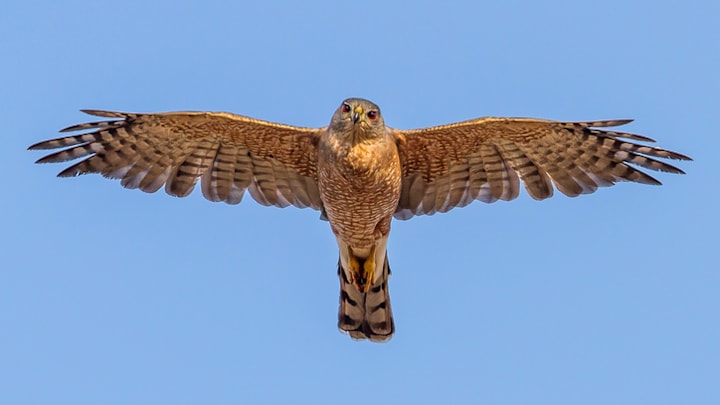Bird | Wing Shape | Size | Nesting Habit | Kills Prey by ... |
|---|---|---|---|---|
Hawk | Broad, rounded | Bigger, chunky | Builds new nests | Grabbing with talons |
Falcon | Tapered, slim | Smaller, graceful | Takes over old nests | Breaking necks with its beak |
No one can mistake the bold appearance of a bald eagle or the hunched figure of a vulture. They are two iconic types of raptor—or birds of prey—characterized by their sharp talons, hooked bills, and keen vision.
Hawks and falcons are also raptors. Some of the most common species include red-tailed hawks, goshawks, and peregrine falcons. But unless you have an encyclopedic knowledge of birds, they can be a little hard to tell apart.
How to Spot the Difference Between Hawks and Falcons
The features of a bird are especially difficult to make out when squinting into the sun from a distance. But a raptor’s silhouette might give you some clues.
If the bird in flight appears to have finger-shaped feathers sticking out from the end of its wings, it is most likely a hawk. Hawks have wings that are rounded and broad, and the birds have a wide wingspan ending in those finger-like feathers. Falcon wings have a sleeker, more clean-cut shape that tapers to a point at the wingtip. In flight, hawks may use their broad wings to soar and fly smoothly with a minimum of flaps, while falcons can appear very fast and agile and display a tendency to hover in one spot.

If you’re lucky enough to spot a raptor close up, take a good look at its eye color. Falcons will always have dark-colored or brown eyes, while the eye color of a hawk can range from hazel to bright yellow to a rather menacing red.
Size is also an indicator of their difference: the size of a hawk ranges from medium to large, while falcons are generally on the smaller side. Curiously, for all raptor species, the female is larger than the male—a phenomenon known as sexual dimorphism.
There’s even a difference in how hawks and falcons kill their prey. Both use their talons to catch a meal, but studies find that falcons have a preference for killing with their beaks. Up close, you can see that falcons have an extra point in their beaks known as a tomial tooth, which help them sever the necks of prey.

Another behavioral difference is nesting. Hawks build their nests from scratch, collecting hard materials like sticks and tree bark before filling it with softer material to protect offspring. Falcons, on the other hand, will simply arrange material that already exists at their chosen nest site, or will even take over an existing nest made by another bird.
Are Hawks and Falcons Endangered?
The World Conservation Union classifies some hawks as endangered or critically endangered. They include Ridgway’s hawk, one of the most endangered raptors in the world; Gundlach’s hawk; and the gray-backed hawk. No falcons are considered endangered, although some have a vulnerable status.
In the mid 20th century, the use of the pesticide DDT in farming and agriculture caused severe population declines in many bird species, including the bald eagle and peregrine falcon. DDT has been banned since the 70s, the affected species have made a remarkable bounce-back, and biologists learned a valuable lesson.

Today, raptors are still threatened by human actions, particularly those which result in a loss of their habitat. Hawks and falcons can be found on every continent except Antarctica and live in nearly every kind of terrain, making conservation a global project.
Even urban cities are home to raptors. Peregrine falcons—the fastest animal on Earth—are especially well adapted to city life. For years they have been making themselves at home on iconic buildings such as the Empire State Building in New York and the Palace of Westminster in London.
Eagles, Ospreys, and Other Raptors
Raptors are a taxonomic group comprised of four main orders: Accipitriformes (hawks, eagles, vultures, kites, buzzards, and osprey), Falconiformes (falcons, kestrels, merlins, and hobbies), Cathartiformes (vultures), and Strigiformes (owls).
However, these classifications are always being updated along with which names are used for which birds. Hawk and falcon are often used as blanket terms for raptors within Accipitriformes and Falconiformes. For example, fish-hawk is another name for an osprey. Confusingly, duck-hawk is also a nickname for the peregrine falcon in North America. So even if you mix up your raptor names, you might still be correct.
